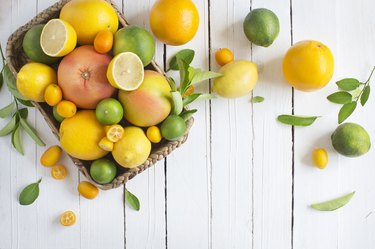
You can test fruit at home to determine the amount of vitamin C it contains by using the vitamin C titration protocol — a vitamin C experiment with iodine. In this experiment, as described by scienceprojectlab.com, the vitamin c indicator is iodine.
Iodine is a strong oxidant that reacts with both vitamin C and starch. When both vitamin C and starch are present in a solution, the iodine first reacts with the vitamin C because the vitamin is a strong antioxidant, as explained by Mayo Clinic.
Video of the Day
Video of the Day
Once the iodine oxidizes all of the vitamin C, the iodine begins to react with the starch. Generally, this experiment uses standardized iodine and starch solutions, as described by the University of Canterbury College of Science. However, testing a reference sample is the answer when standardized solutions are not available.
Vitamin C Reference Sample
Step 1:
Fill the glass jar with 16 oz. of water. Crush the 500 mg vitamin C tablet and pour the tablet pieces into the water. Stir well to dissolve the vitamin C.
Step 2:
Measure 1 oz. of the vitamin C solution and transfer it to another glass. Add 4 oz. of water to the glass. This test glass will contain approximately 31 mg of vitamin C.
Step 3:
Dissolve 1 tsp. of cornstarch in 2 tbsp. of water. Mix the paste until no more dry powder is visible.
Step 4:
Pour 4 oz. of boiling water into a measuring cup. Add the cornstarch paste and stir until dissolved. Let the starch solution cool. Set aside.
Step 5:
Add 1 tsp. of the starch solution to the vitamin C test solution and stir well. This mixture is your vitamin C reference sample.
Test the Reference Sample
Step 1:
Use the eyedropper to add iodine, drop by drop, into the vitamin C reference sample. After you add each drop, stir the solution for 15 seconds. Initially the dark blue color from the iodine drop will disappear completely as you stir the solution. Eventually, the deep blue color will persist despite stirring.
Step 2:
Record the number of iodine drops it took to sustain the blue color. This is the number of drops of iodine required to oxidize 31 mg of vitamin C.
Step 3:
Calculate the number of iodine drops required to oxidize 1 mg of vitamin C by dividing the total drops by 31. For example, if it took 62 drops to sustain the blue color, the formula is 62/31=2. With these sample values, it would take 2 drops of iodine to oxidize 1 mg of vitamin C. Record the number of drops required to oxidize 1 mg using your iodine solution.
Test the Fruit
Step 1:
Juice the fruit you would like to test. Record how many ounces of juice the fruit provided.
Step 2:
Add 1 oz. of the fruit juice to 4 oz. of water in a separate glass and stir well. Add 1 tsp. of the starch solution to the juice and stir well. This is your unknown vitamin C fruit juice sample.
Step 3:
Drop iodine in the juice sample until the blue color persists, stirring between drops. Use the same iodine solution and same eyedropper. Record the total number of drops of iodine required to produce the blue color.
Step 4:
Calculate the amount of vitamin C per ounce of fruit juice. Divide the total number of iodine drops by the number of drops per mg of vitamin C from the reference sample. For example, if your test fruit required 10 drops of iodine, and the reference sample required 2 drops per 1 mg of vitamin C--the formula would be 10/2=5 or 5 mg of vitamin C per ounce of fruit juice.
Step 5:
Determine the approximate amount of vitamin C in the entire fruit by multiplying the amount of vitamin C per ounce by the number of total ounces of juice you obtained in Step 1. For example, if you obtained 3 oz. of juice, and each ounce contained 5 mg of vitamin C, the total vitamin C content of the fruit would be 3 oz.x 5 mg=15 mg of vitamin C.
Things You'll Need
Iodine
1 tbsp. corn starch
500 mg vitamin C tablet
Eye dropper
Measuring cup
Measuring spoons
Clear glass jar
2 clear glass drinking glasses
Spoon
Small mixing bowl
Juicer
Test fruit
Tip
If you do not have a 500 mg vitamin C tablet handy, you can still do the experiment. To calculate the amount of vitamin C in 1 test oz., divide the number of mg in the vitamin C tablet by 16 oz. For example, if you use a 1000 mg vitamin C tablet, 1000/16=62.5 mg of vitamin C in every oz. of solution.
Warning
The numbers of drops of iodine used in the examples are not accurate. The numbers were chosen for simplicity only. The examples given do not reflect actual experiments.